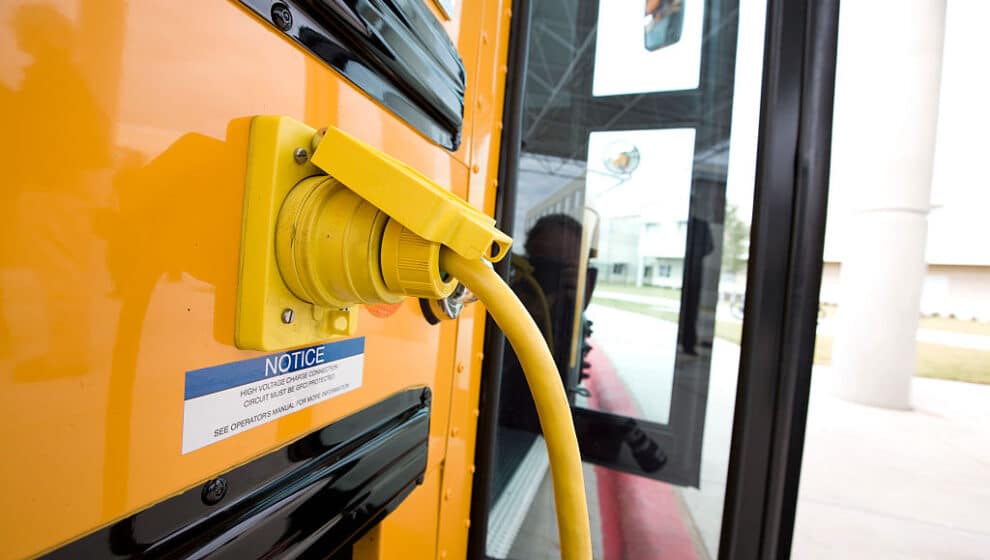Billions of dollars in funding are being put into U.S. school districts to electrify their bus fleets.
Key Details
- The climate footprint of a diesel school bus is about 3.3 pounds of carbon dioxide equivalent per mile, more than double the per-mile footprint for a bus powered on the average U.S. electric grid, according to Argonne National Laboratory.
- Diesel exhaust is also carcinogenic and specific particles in the exhaust fumes are being linked to asthma and other respiratory problems in children, according to Bloomberg.
- In 2016, the U.S. only had 10 electric school buses, and by December 2022, that number had risen to 5,612 and is expected to continue growing with added support from the 2021 Bipartisan Infrastructure Law and the 2022 Inflation Reduction Act.
- Since electric buses have far fewer moving parts than their diesel counterparts, maintenance costs are significantly lower. Maintenance costs are about half of what they are for diesel vehicles, and management costs are just 35% compared to diesel, according to Enelx.
Why it’s news
Nationwide, diesel-powered school buses produce more than 5 million tons of carbon-dioxide emissions while also generating air pollutants that are harmful to children’s health.
As the U.S. pushes toward vehicle electrification to reduce emissions, the next step is electrifying as much of America’s school bus fleets as possible. School buses are the largest mass transportation system in the country, and turning it electric would drastically decrease emissions.
Not only do school buses give off high amounts of carbon dioxide, but they are also the perfect model for electrification. During the summer, school buses typically have a break and will not have to pull energy from the power grid when it generally is at its peak from people cooling their homes. Bus batteries could also be used to send power back to the grid during peak times.
An electric bus range is typically around 100 miles, which covers most bus routes. The bus can pick up kids in the morning, recharge while in school, take them home, and then fully charge overnight.
For now, though, electric buses still make up less than 1% of the school buses on U.S. roads, according to Bloomberg. Although the number is small, increased demand and funding, technological innovation, and a streamlined supply chain are boosting electric bus fleets nationwide.
Most school districts are testing the buses by ordering one or two with plans of ordering more if they work well. School buses are expensive, and electric ones are even more costly, but there are many funding opportunities for schools to receive large donations to cover the extra costs of the vehicles.
New school buses can cost anywhere from $90,000 to $290,000, depending on the make, while an electric bus can cost anywhere from $250,000 to $440,000, according to CNBC.
Although electric buses are more costly, many funding options are available, and prices have dropped dramatically as new materials become available from the Inflation Reduction Act. Also, some businesses are repurposing diesel buses to make them a more affordable and sustainable electric option.
A repurposed bus can range from $100,000 to $175,000, but a downside is sometimes the repurposed vehicles have a shorter lifespan than a brand-new electric school bus.
As the U.S. pushes for electrification—more funding is making its way to U.S. fleets. As part of the Diesel Emissions Reduction Act program and the American Rescue Plan, the EPA funded the replacement of 53 diesel buses with electric ones between 2019 and 2021, according to Bloomberg.
The passage of the Bipartisan Infrastructure Law in 2021 helped continue the push by introducing the Clean School Bus Program. It has a $5 billion budget through the fiscal year 2026, making it the largest pot of money for low- and zero-emission buses.
The EPA plans to offer roughly $1 billion every year until the money runs out, and more programs, such as the Inflation Reduction Act, are offering funding to continue school bus electrification.
Electric buses also require less maintenance than traditional diesel-fueled vehicles. Since an electric engine has fewer parts than an internal combustion engine, it requires less maintenance.
The reason for less maintenance is that there are fewer fluids, such as engine oil, that require regular maintenance, brake wear is significantly reduced due to regenerative braking, and there are far fewer moving parts relative to a conventional fuel engine, according to The Department of Energy.
